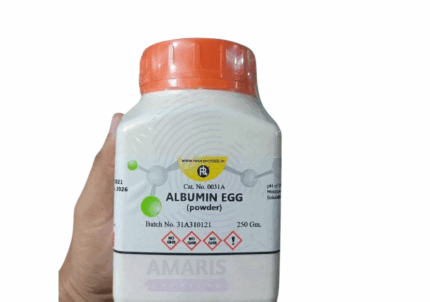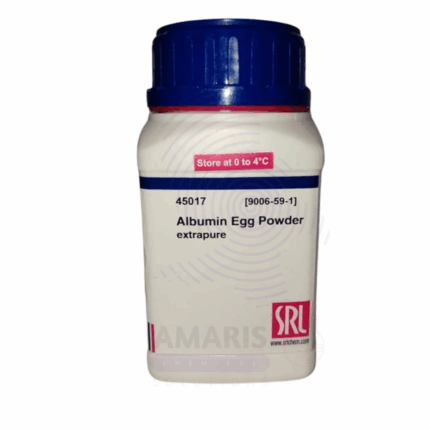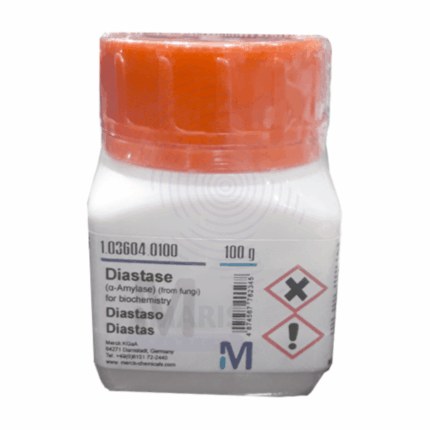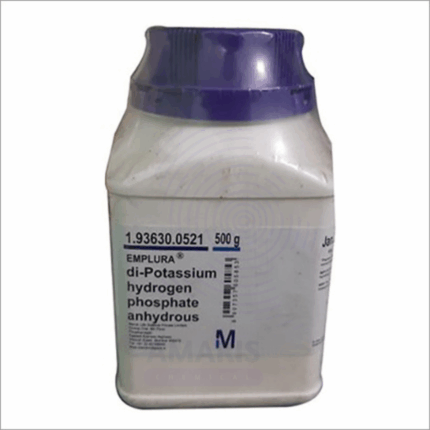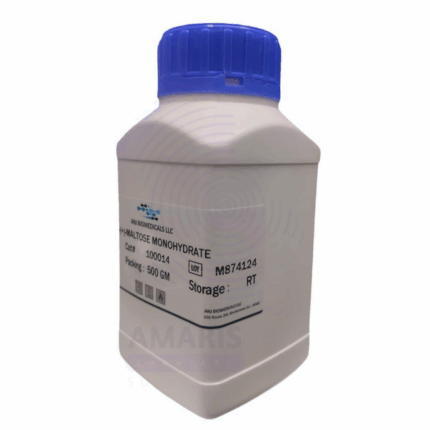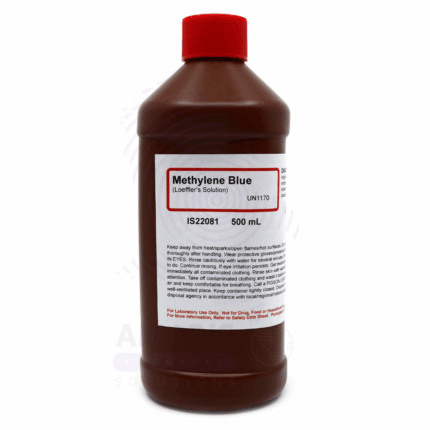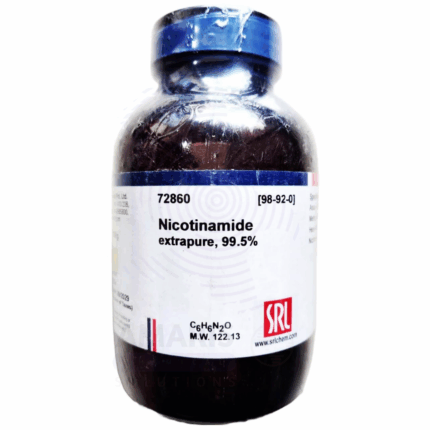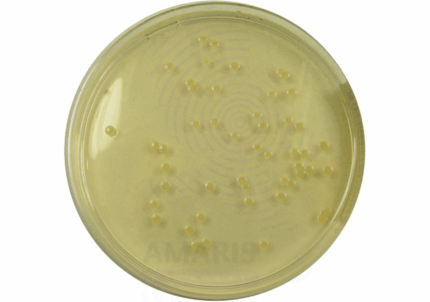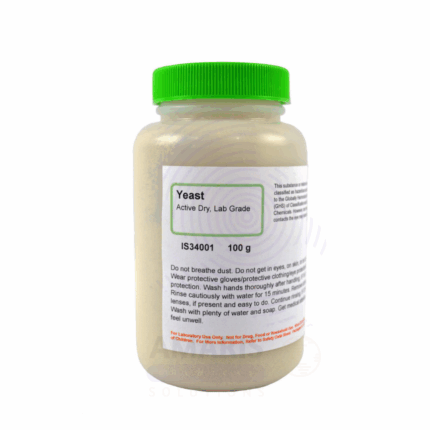
Field Stain A and B Extra Pure
$ 18.20 Original price was: $ 18.20.$ 18.09Current price is: $ 18.09.
Field Stain A and B Extra Pure are specially formulated biological stains used primarily in hematology and microbiology for rapid differential staining of blood smears and parasites, especially in field conditions. Field Stain A typically contains methylene blue and azure dyes dissolved in a phosphate buffer, which preferentially stains the nuclei and cytoplasm of white blood cells. Field Stain B, on the other hand, contains eosin and counterstains the red blood cells and other acidic cellular components. Together, these stains provide excellent contrast and clarity, making them ideal for identifying malarial parasites and conducting quick diagnostic assessments in low-resource or remote environments. Their extra pure quality ensures minimal contamination, consistent performance, and reliable results in both clinical and educational settings.
Field Stain A and B Extra Pure
Primary Uses
- Microscopic examination of blood smears:
Field Stain A (basic dye – methylene blue/azure) and Field Stain B (acidic dye – eosin) are primarily used together for rapid differential staining of blood films, particularly for identifying malaria parasites, trypanosomes, and other blood-borne pathogens. - Diagnostic hematology:
Vital for differentiating blood cells such as leukocytes, erythrocytes, and platelets under light microscopy in clinical labs and field settings.
Secondary Uses
- Parasitology field testing:
Favored in remote or low-resource settings due to its fast action and minimal need for lab infrastructure, supporting on-site diagnosis of parasitic infections. - Educational and training purposes:
Used in teaching laboratories for demonstrating blood cell morphology and staining techniques to students and trainees in hematology and pathology. - Comparative staining studies:
In research, it is sometimes used for comparing stain quality, efficiency, and morphological clarity with other stains like Giemsa or Wright’s.
| PACK SIZE |
25 grams Plastic Tin |
|---|
1. Basic Identification Attributes
- Product Name: Field Stain A and Field Stain B
- Type: Biological staining reagents (Romanowsky-type stains)
- Grade: Extra Pure (Laboratory Reagent Grade)
- Appearance:
- Field Stain A: Dark blue to purple solution (methylene blue + Azure I)
- Field Stain B: Reddish solution (Eosin Y in buffer)
2. Composition
- Field Stain A:
- Methylene Blue
- Azure I
- Glycerin
- Solvent (often ethanol or methanol)
- Field Stain B:
- Eosin Y
- Buffered aqueous or alcohol-based solution
3. Physical & Chemical Properties
- Solubility: Fully soluble in alcohols and water (depending on formulation)
- pH Range:
- A: Typically slightly basic
- B: Typically acidic (pH ~5–6)
- Stability: Stable in tightly sealed bottles, light-sensitive
- Storage: Store in cool, dry place away from light
4. Safety & Hazard Attributes
- GHS Classification:
- May contain components harmful if swallowed or inhaled
- Irritant to eyes and skin
- Hazard Statements:
- H315: Causes skin irritation
- H319: Causes serious eye irritation
- H335: May cause respiratory irritation
- PPE Requirements:
- Lab coat
- Nitrile gloves
- Eye protection
- Use under fume hood if aerosolized or heated
- First Aid Measures:
- Inhalation: Fresh air, seek attention if symptoms persist
- Skin Contact: Wash thoroughly with water
- Eye Contact: Flush with water for 15 minutes
- Ingestion: Rinse mouth, do not induce vomiting; seek medical attention
5. Storage & Handling Attributes
- Storage Conditions:
- Keep tightly closed
- Store at room temperature, away from heat and sunlight
- Avoid contamination between bottles
- Handling Notes:
- Shake before use if sedimented
- Use clean applicators to avoid microbial contamination
6. Regulatory & Compliance Attributes
- Field Stain A CAS Numbers (components):
- Methylene Blue: 61-73-4
- Azure I: 531-53-3
- Field Stain B CAS (Eosin Y): 17372-87-1
- Hazard Class: Not regulated as dangerous goods (small quantities)
- UN Number: Not applicable
7. Laboratory Applications
- Primary Uses:
- Hematological staining of blood smears, especially for malaria parasite detection
- Commonly used in field microscopy
- Differential staining of cytoplasm and nuclei
- Secondary Uses:
- Quick diagnostics in medical field labs
- Educational demonstrations of blood smear techniques
- Detection of protozoa and cell morphology in biological samples
SAFETY PRECAUTIONS
- May cause skin, eye, or respiratory irritation
- Use gloves and eye protection when handling
- Work in a well-ventilated area
Storage:
- Keep in tightly sealed amber bottles
- Store at room temperature, away from direct light and heat
FIRST AID MEASURES
- Inhalation: Move to fresh air
- Eye Contact: Rinse cautiously with water for several minutes
- Skin Contact: Wash off with soap and water
- Ingestion: Rinse mouth, seek medical attention if symptoms persist


 Preservatives(food)
Preservatives(food) Flavor Enhancers
Flavor Enhancers Acidulants
Acidulants Sweeteners
Sweeteners Antioxidants
Antioxidants Colorants(food)
Colorants(food) Nutraceutical Ingredients (food)
Nutraceutical Ingredients (food) Nutrient Supplements
Nutrient Supplements Emulsifiers
Emulsifiers
 Collectors
Collectors Dust Suppressants
Dust Suppressants Explosives and Blasting Agents
Explosives and Blasting Agents Flocculants and Coagulants
Flocculants and Coagulants Frothers
Frothers Leaching Agents
Leaching Agents pH Modifiers
pH Modifiers Precious Metal Extraction Agents
Precious Metal Extraction Agents
 Antioxidants(plastic)
Antioxidants(plastic) Colorants (Pigments, Dyes)
Colorants (Pigments, Dyes) Fillers and Reinforcements
Fillers and Reinforcements Flame Retardants
Flame Retardants Monomers
Monomers Plasticizers
Plasticizers Polymerization Initiators
Polymerization Initiators Stabilizers (UV, Heat)
Stabilizers (UV, Heat)
 Antifoaming Agents
Antifoaming Agents Chelating Agents
Chelating Agents Coagulants and Flocculants
Coagulants and Flocculants Corrosion Inhibitors
Corrosion Inhibitors Disinfectants and Biocides
Disinfectants and Biocides Oxidizing Agents
Oxidizing Agents pH Adjusters
pH Adjusters Scale Inhibitors( water)
Scale Inhibitors( water)
 Antioxidants(cosmetic)
Antioxidants(cosmetic) Emollients
Emollients Fragrances and Essential Oils
Fragrances and Essential Oils Humectants
Humectants Preservatives
Preservatives Surfactants(cosmetic)
Surfactants(cosmetic) Thickeners
Thickeners UV Filters
UV Filters
 Fertilizers
Fertilizers Soil Conditioners
Soil Conditioners Plant Growth Regulators
Plant Growth Regulators Animal Feed Additives
Animal Feed Additives Biostimulants
Biostimulants Pesticides (Herbicides, Insecticides, Fungicides)
Pesticides (Herbicides, Insecticides, Fungicides)
 Active Pharmaceutical Ingredients (APIs)
Active Pharmaceutical Ingredients (APIs) Excipients
Excipients Solvents(pharmaceutical)
Solvents(pharmaceutical) Antibiotics
Antibiotics Antiseptics and Disinfectants
Antiseptics and Disinfectants Vaccine Adjuvants
Vaccine Adjuvants Nutraceutical Ingredients (pharmaceutical)
Nutraceutical Ingredients (pharmaceutical) Analgesics & Antipyretics
Analgesics & Antipyretics
 Analytical Reagents
Analytical Reagents Solvents(lab)
Solvents(lab) Chromatography Chemicals
Chromatography Chemicals Spectroscopy Reagents
Spectroscopy Reagents microbiology-and-cell-culture-reagents
microbiology-and-cell-culture-reagents Molecular Biology Reagents
Molecular Biology Reagents Biochemical Reagents
Biochemical Reagents Inorganic and Organic Standards
Inorganic and Organic Standards Laboratory Safety Chemicals
Laboratory Safety Chemicals Specialty Laboratory Chemicals(Special Laboratory Equipment)
Specialty Laboratory Chemicals(Special Laboratory Equipment)
 Demulsifiers
Demulsifiers Hydraulic Fracturing Fluids
Hydraulic Fracturing Fluids Scale Inhibitors(oil)
Scale Inhibitors(oil) Surfactants(oil)
Surfactants(oil) Drilling Fluids
Drilling Fluids
 Dyes and Pigments
Dyes and Pigments Bleaching Agents
Bleaching Agents Softening Agents
Softening Agents Finishing Agents
Finishing Agents Antistatic Agents
Antistatic Agents
 Admixtures
Admixtures Waterproofing Agents
Waterproofing Agents Sealants and Adhesives
Sealants and Adhesives Curing Compounds
Curing Compounds Concrete Repair Chemicals
Concrete Repair Chemicals Anti-Corrosion Coatings
Anti-Corrosion Coatings
 Surfactants(cleaning)
Surfactants(cleaning) Builders
Builders Enzymes
Enzymes Solvents (Cleaning)
Solvents (Cleaning) Fragrances
Fragrances
 Electronic Chemicals
Electronic Chemicals Catalysts
Catalysts Lubricants
Lubricants Photographic Chemicals
Photographic Chemicals Refrigerants
Refrigerants Automotive chemicals
Automotive chemicals Pyrotechnic Chemicals
Pyrotechnic Chemicals
 Biodegradable Surfactants
Biodegradable Surfactants Bio-based Solvents
Bio-based Solvents Renewable Polymers
Renewable Polymers Carbon Capture Chemicals
Carbon Capture Chemicals Wastewater Treatment Chemicals
Wastewater Treatment Chemicals
 Pigments
Pigments Solvents(paint)
Solvents(paint) Specialty Coatings
Specialty Coatings Binders/Resins
Binders/Resins Additives
Additives Driers
Driers Anti-Corrosion Agents
Anti-Corrosion Agents Functional Coatings
Functional Coatings Application-Specific Coatings
Application-Specific Coatings
 Fresh Herbs
Fresh Herbs Ground Spices
Ground Spices Whole Spices
Whole Spices Spice Blends
Spice Blends Dried Herbs
Dried Herbs
 Leavening Agents
Leavening Agents Dough Conditioners
Dough Conditioners Flour Treatments
Flour Treatments Fat Replacers
Fat Replacers Decoratives
Decoratives Preservatives(baking)
Preservatives(baking)
 Plasticizers & Softeners
Plasticizers & Softeners Reinforcing Agents
Reinforcing Agents Adhesion Promoters
Adhesion Promoters Vulcanizing Agents
Vulcanizing Agents Antidegradants
Antidegradants Blowing Agents
Blowing Agents Fillers & Extenders
Fillers & Extenders Accelerators & Retarders
Accelerators & Retarders


